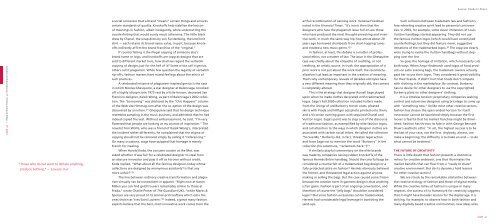Testimony of David Wolfe, Creative Director The ... - Public Knowledge
Testimony of David Wolfe, Creative Director The ... - Public Knowledge
Testimony of David Wolfe, Creative Director The ... - Public Knowledge
Create successful ePaper yourself
Turn your PDF publications into a flip-book with our unique Google optimized e-Paper software.
E s s a y s : Ready t o S h a r e<br />
a social consensus that a brand “means” certain things and ensures<br />
artful recombination <strong>of</strong> existing work. Vanessa Friedman<br />
Such collisions between trademark law and fashion’s<br />
certain standards <strong>of</strong> quality. Knock<strong>of</strong>fs help stabilize the lexicon<br />
noted in the Financial Times: “It’s ironic then that the<br />
free-wheeling creative spirit lead to perennial controver-<br />
<strong>of</strong> meanings in fashion, albeit inelegantly, while undercutting the<br />
designers who face the plagiarism issue full-on are those<br />
sies. In 2003, for example, some clever imitations <strong>of</strong> Louis<br />
counterfeiting that would surely result otherwise. <strong>The</strong> little black<br />
who have produced the most thought-provoking and inven-<br />
Vuitton handbags started appearing. <strong>The</strong>y did not use<br />
dress by Chanel, the wrap dress by von Furstenberg, the Izod knit<br />
tive work, in much the same way hip-hop artists about 20<br />
the famous Vuitton logos (which would have constituted<br />
shirt — each retains its brand-name value, in part, because knock<strong>of</strong>fs<br />
indirectly affirm the brand franchise <strong>of</strong> the “original.”<br />
years ago borrowed drumbeats from chart-topping tunes<br />
and created a new music genre.” 33<br />
counterfeiting), but they did feature clever, suggestive<br />
imitations <strong>of</strong> the trademarked logos. 36 <strong>The</strong> copycats clearly<br />
If counterfeiting is the illegal copying <strong>of</strong> someone else’s<br />
In fashion, at least, this debate is a matter <strong>of</strong> pr<strong>of</strong>es-<br />
were trying to evoke the Vuitton handbags without step-<br />
brand name or logo, and knock<strong>of</strong>fs are copycat designs that are<br />
sional ethics, not a matter <strong>of</strong> law. <strong>The</strong> issue in the Ghesquière<br />
ping over the line.<br />
sold to different market tiers, how shall we regard the verbatim<br />
case was chiefly about the etiquette <strong>of</strong> crediting, or not<br />
So goes the homage <strong>of</strong> imitation, which necessarily cuts<br />
page 40 | Ready to Share: Fashion & the Ownership <strong>of</strong> Creativity<br />
copying <strong>of</strong> designs just for the hell <strong>of</strong> it? Some critics call it genius,<br />
others call it plagiarism. While few question the legality <strong>of</strong> verbatim<br />
rip-<strong>of</strong>fs, fashion mavens have mixed feelings about the ethics <strong>of</strong><br />
such practices.<br />
A celebrated instance <strong>of</strong> plagiarism-inspired genius is the case<br />
in which Nicolas Ghesquière, a star designer at Balenciaga, knocked<br />
<strong>of</strong>f a highly idiosyncratic 1973 vest by a little-known, deceased San<br />
Francisco designer, Kaisik Wong, as part <strong>of</strong> Balenciaga’s 2002 collection.<br />
<strong>The</strong> “borrowing” was disclosed by the “Chic Happens” column<br />
<strong>of</strong> the Web site Hintmag.com after the co-option <strong>of</strong> the design was<br />
discovered by an intern. 30 Ghesquière said that his design technique<br />
resembles sampling in the music business, and admitted that he had<br />
indeed copied the vest. Without embarrassment, he said, “I’m very<br />
flattered that people are looking at my sources <strong>of</strong> inspiration.” <strong>The</strong><br />
novelist Tom <strong>Wolfe</strong>, who was a friend <strong>of</strong> Kaisik Wong’s, interpreted<br />
the incident rather differently; he complained that the stigma <strong>of</strong><br />
crediting, an artistic source. In truth, the appropriation <strong>of</strong> a<br />
prior work is not just about the work itself; the recontextualization<br />
is at least as important in the creation <strong>of</strong> meaning.<br />
That’s why contemporary revivals <strong>of</strong> decades-old styles have<br />
a very different meaning than they originally did; the context<br />
is completely altered.<br />
This is the strategy that designer Russell Sage played<br />
upon when he made clothes decorated with trademarked<br />
logos. Sage’s Fall 2000 collection included halters made<br />
from the linings <strong>of</strong> old Burberry trench coats, pleated<br />
skirts with Prada and Hilfiger ads photo printed onto them,<br />
and a Victorian evening gown with sequined Chanel and<br />
Vuitton logos. Sage’s point was to step out <strong>of</strong> the discourse<br />
<strong>of</strong> traditional fashion, as exemplified by elite fashion logos,<br />
and call attention to the ways in which designer clothes are<br />
associated with certain social tribes. He called the collection<br />
both ways. When Anya Hindmarch used logos <strong>of</strong> food products<br />
on satin evening bags, the trademark owners actually<br />
paid her to use their logos. <strong>The</strong>y considered it great visibility<br />
for their brands. It didn’t hurt that foods don’t compete<br />
with clothing in the marketplace. By contrast, Burberry<br />
has no desire for other designers to use the copyrighted<br />
Burberry plaid on other designers’ clothing.<br />
It is a timeless tension: proprietary companies seeking<br />
control and subversive designers using bricolage to come up<br />
with “something new.” Unlike most other creative sectors,<br />
fashion has chosen the open-ended horizon for itself.<br />
Innovation cannot be squelched simply because the first<br />
mover is fearful that his market franchise might be diminished.<br />
Fashion has thrown its fate in with George Bernard<br />
Shaw’s aesthetic ethic: “In art, the highest success is to be<br />
the last <strong>of</strong> your race, not the first. Anybody, almost, can<br />
copying should not be removed simply by calling it “referencing.”<br />
“So Sue Me.” Burberry did, in fact, threaten legal action<br />
make a beginning; the difficulty is to make an end — to do<br />
On many occasions, wags have quipped that homage is merely<br />
French for stealing.<br />
When Harold Koda, the costume curator at the Met, was<br />
asked whether it was fair for a celebrated designer to steal from<br />
and force Sage not to mention the word “Burberry” in the<br />
collection (his substitute, “reclaimed check.”) 34<br />
A similarly playful commentary on the elite brands<br />
was made by companies issuing rubber knock<strong>of</strong>fs <strong>of</strong> the<br />
what cannot be bettered.”<br />
the future <strong>of</strong> creativity<br />
<strong>The</strong>re is little doubt that fashion presents a distinctive<br />
“Those who do not want to imitate anything,<br />
produce nothing.” — Salvador Dali<br />
an obscure innovator and pass it <strong>of</strong>f as his own without credit,<br />
Koda replied, “What about all the famous designers today whose<br />
collections are designed by anonymous assistants? Is that any<br />
more unfair?” 31<br />
famous Hermès Birkin handbag. Should the colorful bags be<br />
considered a counterfeit <strong>of</strong> a trademarked bag design or a<br />
fully protected satire on fashion? Hermès obviously believed<br />
the former, and threatened legal action against anyone<br />
milieu for creative endeavor, one that illuminates the<br />
market benefits that can flow from a “ready to share”<br />
creative environment. But do its dynamics hold lessons<br />
for other creative sectors?<br />
<strong>The</strong> line between ordinary creative transformation and plagia-<br />
making or selling the bags. But the case caused some frisson<br />
We are struck by the remarkable similarities between<br />
rism virtually can be nonexistent in apparel. “Right now at Karen<br />
because the creative norm in garment design is that anything<br />
the creative ecology <strong>of</strong> fashion and those <strong>of</strong> digital media.<br />
Millen you can find gold trousers remarkably similar to those at<br />
is fair game. Fashion is part <strong>of</strong> an ongoing conversation, and<br />
While the creative milieu <strong>of</strong> fashion is unique in many<br />
Prada,” wrote Charlie Porter <strong>of</strong> <strong>The</strong> Guardian (UK), “while Marks &<br />
therefore <strong>of</strong> course the “jelly bags” should be considered<br />
respects, the success <strong>of</strong> its framework for creativity suggests<br />
Spencer are very proud <strong>of</strong> its animal-print kaftans which echo the<br />
legal. 35 But since fashion accessories can be trademarked,<br />
that it might have broader lessons for the digital age. It is<br />
ones shown at Yves Saint Laurent.” 32 Indeed, a great many fashion<br />
Hermès had considerable legal leverage in banishing the<br />
striking, for example, to observe how in both fashion and<br />
experts believe that the best, most innovative work comes from the<br />
send-ups.<br />
many digitally based creative communities, new ideas arise<br />
page 41





